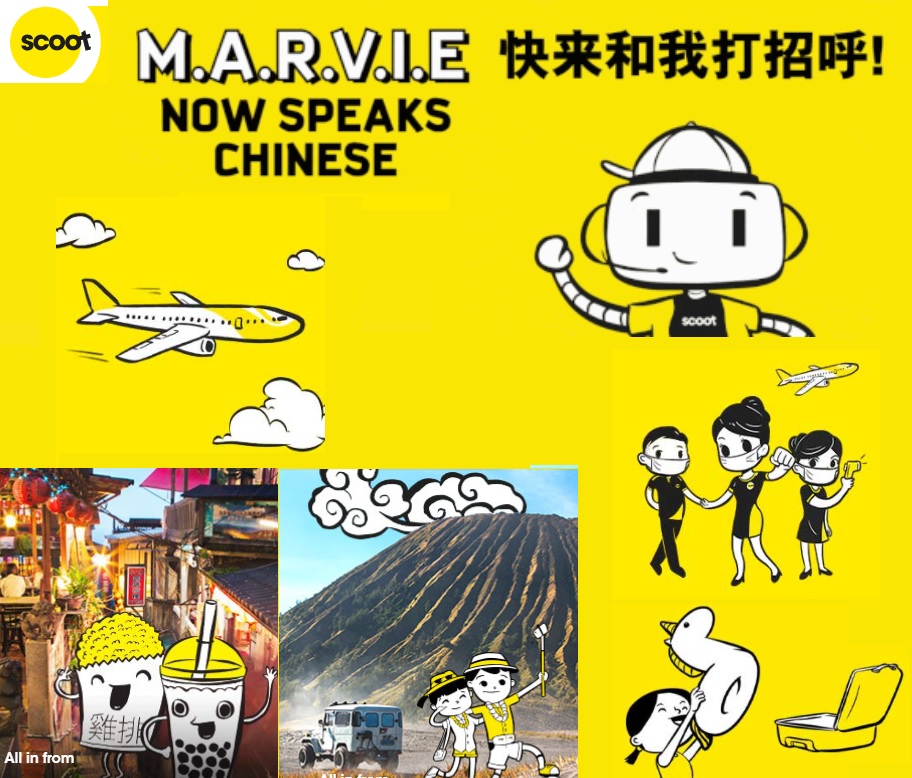
ChinaTravelNews, Ritesh Gupta – Every consumer today expects a travel brand to be proactive on a couple of counts – answer every possible query related to a trip and ensuring one doesn’t need to wait for long for the same. And on this count, a tool like a chatbot can play a vital role. And if all of this can be done via a native language, then it shows that airlines care.
Singapore-based Scoot has just done that for travelers, who prefer to communicate in the Chinese language.
The airline’s decision to introduce a Chinese chatbot has come at a time when Singapore is in news for lifting border restrictions on visitors from mainland China in the first week of November. Also, as per one’s chatbot experience on Facebook Messenger, Scoot has already been answering queries related to safety measures, travel advisory, refund and cancellation, flight schedule and transit in Singapore. So to work on such a detailed offering for Chinese travelers is a practical move.
Scoot has once again lived up to its reputation of being a digitally forward airline. When launched in 2018, M.A.R.V.I.E. was the first chatbot by an Asian airline that, in addition to assisting with customers’ queries, also allowed payment transactions.
M.A.R.V.I.E in Chinese
“Since Scoot launched M.A.R.V.I.E. (Most Awesome and Resourceful Virtual Intern Ever) on our Facebook Messenger in 2018, we have observed that apart from English, there are increasingly more customers who have requested for assistance from or spoken to M.A.R.V.I.E in Chinese. As such, to better engage Chinese-speaking customers on Facebook, we have given him some language training such that he can understand simplified or traditional Chinese, and is able to reply in traditional Chinese,” Lee Yong Sin, General Manager, China told ChinaTravelNews.com.

Lee Yong Sin, General Manager, China
Scoot worked with Barcelona, Spain-based Caravelo for this offering.
Various aspects such as the personality, tone, written language etc. were delved into for the functioning of the chatbot. Traditional Chinese as opposed to simplified Chinese was chosen considering that it is used primarily in Macau, HK and Taiwan as well, shared Jess Evans, product marketing specialist at Caravelo.
“To localize the chatbot, apart from translating all the English content to traditional Chinese, we also had to ensure that the expressions used by the chatbot align with our brand personality of being fun and cheeky. In addition, we also constantly train the chatbot and update its knowledge database to ensure that information provided to customers are relevant and up to date,” said Yong Sin.
As for now, the Chinese chatbot has same functionalities as in English.
* Search and book direct flight
* Retrieve booking
* Post-ancillary sales
* Abandoned cart notification
* Resend itinerary
* Feedback
Yong Sin shared that the chatbot can now assist customers to search for flights, display the same fares and availability as reflected on Scoot’s website and mobile app, make flight bookings, enable payments by credit card, enable customers to purchase add-ons after booking their flights, and even check in online for their flights (for flights departing from Singapore).
“Of course, customers who have queries that cannot be answered by M.A.R.V.I.E. also have the option to connect to a customer service agent for assistance,” he said. “Since Covid-19 hit, our customer service team has been experiencing a higher than usual volume of queries relating to refund policies, flight schedule, transit operations and safety measures. With M.A.R.V.I.E., customers are able to obtain answers to their queries quickly and conveniently without having to contact our call centre. It also allows our customer service team and call centre to have greater capacity to assist customers with more complex and urgent issues.”
Taking care of concerns, the chatbot conveys safety measures (pre-flight and onboard) implemented by the airline, the new booking policy (chance to change flight time/date once for free) and updated flight schedule. “We display advice in the bot but because the advice changes quite regularly, to avoid errors, we direct to Scoot's up to date website,” added Jess.
As for the hurdles faced, Jess shared, “One unique challenge was to customise the format of the dates for Chinese. Another fact is, more than a challenge, I’d say it was an advantage. Thanks to the idiosyncrasies of the Chinese language, the chatbot’s responses can be made shorter and the buttons labels more concise (i.e. a whole sentence fits), compared to English.”
“We’ve done chatbots in Russian and Ukrainian, which are difficult as they have dative cases and more nuanced formalities. They are harder to automate because of the grammar. But Chinese is easier because less likely to make a typo and confuse the bot! We enjoyed making MARVIE,” explained Jess.
The plan is introduce new features going forward. As of now, a user cannot pay via Alipay or WeChat Pay while on a chatbot yet.
Yong Sin shared, “It is also in our product development pipeline to integrate a chatbot on our WeChat official account so as to better serve our customers in China. The team is currently working hard on this project, and we hope to launch it in the next year or so, where customers can look forward to having their queries answered promptly and round the clock.”




